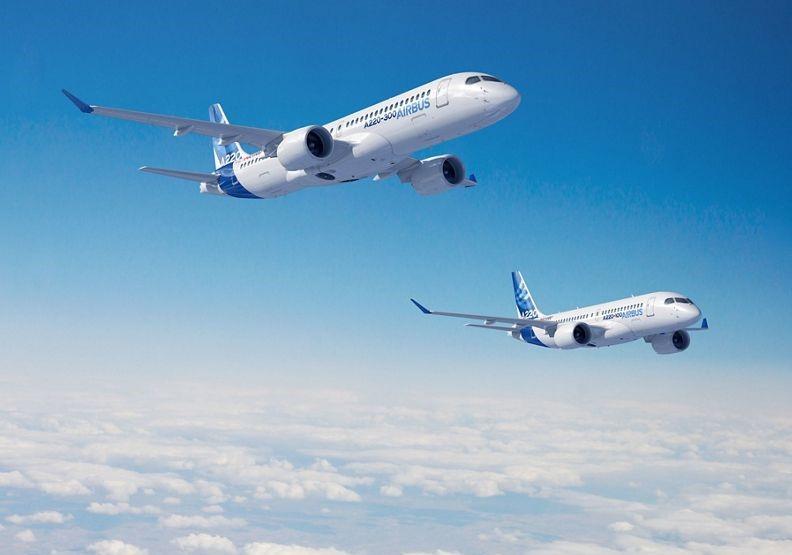ボンバルディアが 残りのA220株式をケベックのエアバスに売却

エアバスとケベック州政府は、カナダの製造業者が民間航空機事業からの撤退を完了したため、A220プログラムの残りのボンバルディアの株式を買い取った。
本合意は直ちに有効となり、エアバスは50.1%から75%に出資比率を引き上げ、ケベックはエアバスカナダリミテッドパートナーシップ(エアバスカナダ)の25%を保有することになる。ボンバルディアが本取引から591百万ドルを受け取った。ケベックのすでに保有する16%の株式からの増加は、「現金対価なし」となる。
ボンバルディアは巨額の財政的プレッシャーにさらされており、高額の負債を抱えているため、同社はそれを安定させることができる抜本的な対策を模索している。ボンバルディアはCRJプログラムを三菱に、Q400ターボプロップをロングビューアビエーションキャピタルの子会社であるデハビランドカナダに売却することにすでに同意している。2019年後半、スピリットエアロシステムズは、北アイルランド、モロッコ、米国の施設を含むボンバルディアの航空構造ビジネスの一部の買収に同意した。
同社はまた、ボンバルディア輸送またはビジネス航空機ユニットでの列車アクティビティーのいずれかを売却について協議中である。
「私たちはこの素晴らしい航空機プログラムに取り組んでおり、ケベック州とカナダの航空宇宙産業に長期的な可視性をもたらすという野望を元にでケベック州政府と提携している」とエアバスのCEOギヨーム・フォーリー氏は述べた。
「私たちの政府がこの合意できたことを誇りに思う」とケベック首相のフランソワ・ルゴー氏は発言した。「私たちが就任した際にこの点で直面していた大きな課題にもかかわらず、ケベックで発展した有給の仕事と例外的な専門知識を保護することに成功を収めた。プログラムに再投資しないというコミットメントを尊重しながら、パートナーシップにおける政府の立場を強化した。」
「この取引は、資本構造に対処する取り組みを支援し、商業航空宇宙からの戦略的撤退を完了する。」とボンバルディアの社長兼CEOであるアラン・ベルマーレは述べ、次に続けた。 「ボンバルディアが商業航空業界にもたらした多くの成果と多大な影響を非常に誇りに思ってる。私たちは、ケベック州とカナダの雇用を維持し、航空宇宙クラスターを強化した責任ある方法を誇りに思っている。A220プログラムは、エアバスとケベック州政府のスチュワードシップの下で長く成功を収めることができると確信している。」
エアバスは現在、シングルアイルビジネスの大規模な戦略的資産にアクセスできるだけでなく、ボンバルディアの財政的制約がなくなった。エアバスは、A220-100および-300の658件の注文を収集しており、生産を拡大中である。ケベック州ミラベルの元の最終組立施設に加えて、エアバスはアラバマ州モービルに別のA220ラインを設置するプロセスを進めており、今年後半に最初の航空機をデルタ航空に納入する予定がある。モバイルは、フル稼働時に月に4機の航空機を生産することになる。
重要なことは、エアバスは現在、A220へのさらなる投資を自由に検討することが可能になった。とりわけ、エアバスは、ブリーズエアのCEOであるデビッド・ニールマン氏と、航空機の航続距離を4,000 nm以上に大幅に拡大し、米国大陸横断および大西洋横断ミッションを可能にすることについて話し合っている。さらに、エールフランス-KLMなどの航空会社はエアバスに、ボーイング737-8および独自のA320neoと競合する-300の拡張バージョンであるA220-500を生み出すための働きかけています。アナリストが信じているように、それは大幅に低ユニットコストとなる。
エアバスの最高経営責任者であるクリスチャン・シェラー氏は、最近、そのような航空機は「可能かどうかの問題ではなく、いつなのか」と発言している。
A220はエアバスにとって非常に重要である。A320neo系統の代替え高級志向を180〜200席から始め、ナローボディ市場の最下部での最新の製品を提供できるためだからである。
取引の一環として、ケベック州は当初計画よりも3年間長くエアバス・カナダの株式を保持し、少なくとも2026年までは継続して保有する。その株式は「エアバスによって償還可能」であり、100%の株主になるオプションを提供する。取引の詳細と条件は非開示である。
また、ボンバルディアは、A220コックピットと後部胴体を含むエアバスの子会社ステリアエアロスペースにA220およびA330作業パッケージ製品を販売している。
Airbus and the government of Quebec have taken over the remaining Bombardier stake in the A220 program as the Canadian manufacturer completed its exit from the commercial aircraft business.
The agreement, which is effective immediately, sees Airbus increase its stake from 50.1% to 75% while Quebec now holds 25% of Airbus Canada Limited Partnership (Airbus Canada). Bombardier received $591 million from the transaction. Quebec’s increase from the previous 16% stake comes with “no cash consideration.”
With Bombardier under huge financial pressure and burdened by high debt, the company is searching for radical measures that will be able to stabilize it. Bombardier has already agreed to sell the CRJ program to Mitsubishi and the Q400 turboprop to De Havilland Canada, a Longview Aviation Capital subsidiary. In late 2019, Spirit AeroSystems agreed to buy parts of Bombardier’s aerostructures business, including facilities in Northern Ireland, Morocco and the U.S.
The company is also in talks to divest either its train activities in Bombardier transportation or the business aircraft unit.
“We are committed to this fantastic aircraft program and we are aligned with the government of Québec in our ambition to bring long-term visibility to the Québec and Canadian aerospace industry,” Airbus CEO Guillaume Faury said.
“I am proud that our government was able to reach this agreement,” Francois Legault, the Premier of Quebec, said. “We have succeeded in protecting paying jobs and the exceptional expertise developed in Québec, despite the major challenges we faced in this regard when we took office. We have consolidated the government’s position in the partnership, while respecting our commitment not to reinvest in the program.”
“This transaction supports our efforts to address our capital structure and completes our strategic exit from commercial aerospace,” Bombardier president and CEO Alain Bellemare said. “We are incredibly proud of the many achievements and tremendous impact Bombardier had on the commercial aviation industry. We are equally proud of the responsible way in which we have exited commercial aerospace, preserving jobs and reinforcing the aerospace cluster in Québec and Canada. We are confident that the A220 program will enjoy a long and successful run under Airbus’ and the Government of Québec’s stewardship.”
Airbus now not only has access to a massive strategic asset in the single-aisle business, but it also no longer is held back by Bombardier’s financial constraints. Airbus has collected 658 orders for the A220-100 and -300 and is in the process of ramping up production. In addition to the original final assembly facility in Mirabel, Quebec, Airbus is also in the process of setting up another A220 line in Mobile, Alabama which is to deliver the first aircraft to Delta Air Lines later this year. Mobile is to produce four aircraft per month when it is in full swing.
Importantly, Airbus is now also free to consider investing further in the A220. Among others, Airbus is in talks with Breeze Air CEO David Neeleman about a substantial increase in range for the aircraft to more than 4,000 nm, which would make U.S. transcontinental and transatlantic missions possible. What is more, airlines such as Air France-KLM have been lobbying Airbus to build an A220-500 - a stretched version of the -300 which would compete with the Boeing 737-8 and its own A320neo. It would offer, as analysts believe, substantially lower unit costs.
Airbus chief commercial officer Christian Scherer said recently that such an aircraft was “not a question of if, but when.”
The A220 is hugely important for Airbus because it enables it to position an A320neo family replacement upmarket, beginning at 180-200 seats while still being able to offer an up-to-date product at the lower end of the narrowbody market.
As part of the deal, Quebec will stick to its shareholding in Airbus Canada for three years longer than initially planned and remain a part-owner until at least 2026. Its shares are then “redeemable by Airbus” – giving it the option for full control. Details and conditions of that arrangement are confidential.
Also, Bombardier is selling its A220 and A330 work package production to Airbus subsidiary Stelia Aerospace which includes the A220 cockpit and rear fuselage.